Riccati Equations: Numerical Solutions using Adam-Bashforth & Moulton
VerifiedAdded on 2021/10/01
|57
|7256
|150
Report
AI Summary
This technical report, submitted by students from Universiti Teknologi MARA, investigates the numerical solutions of Riccati differential equations using the Adam-Bashforth and Adam-Moulton methods. The report begins with an introduction to differential equations and the need for numerical methods when analytical solutions are not feasible, highlighting the advantages of multistep methods like Adam-Bashforth and Adam-Moulton over single-step methods. The methodology section details the Adam-Bashforth and Adam-Moulton methods, along with an introduction to the Riccati equation. The implementation section describes the derivation of the methods using Maple and their application in solving the Riccati equation using Matlab, including the coding and analysis of results. The results and discussion sections present and analyze the errors associated with each method, concluding that both methods provide accurate solutions, with Adam-Bashforth showing higher accuracy. The report includes figures and tables to illustrate the methods and results, and it concludes with recommendations for further research.
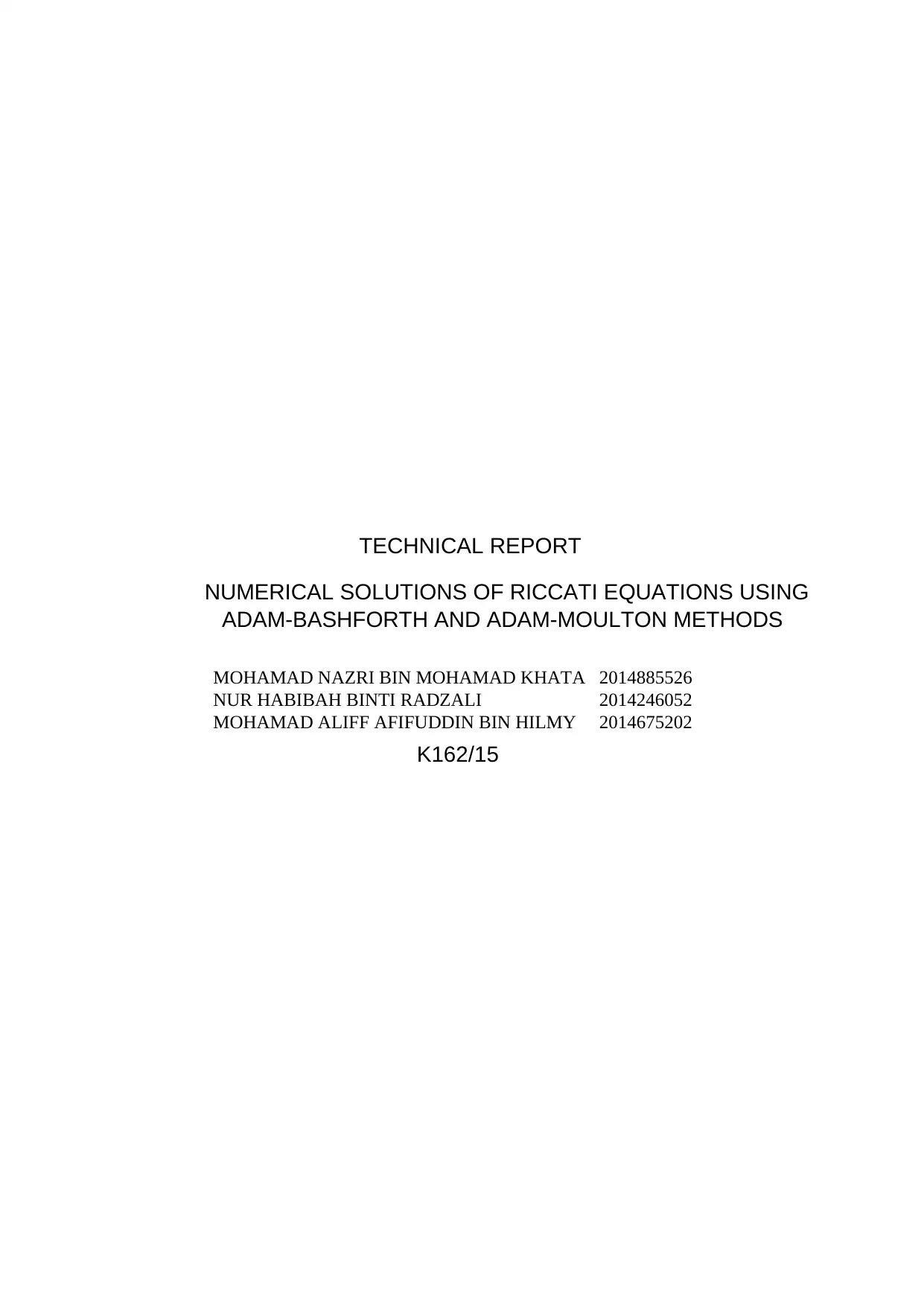
Bachelor of Science (Hons.) Mathematics
Center of Mathematics Studies Faculty of Computer and Mathematical
Sciences
TECHNICAL REPORT
NUMERICAL SOLUTIONS OF RICCATI EQUATIONS USING
ADAM-BASHFORTH AND ADAM-MOULTON METHODS
MOHAMAD NAZRI BIN MOHAMAD KHATA 2014885526
NUR HABIBAH BINTI RADZALI 2014246052
MOHAMAD ALIFF AFIFUDDIN BIN HILMY 2014675202
K162/15
Center of Mathematics Studies Faculty of Computer and Mathematical
Sciences
TECHNICAL REPORT
NUMERICAL SOLUTIONS OF RICCATI EQUATIONS USING
ADAM-BASHFORTH AND ADAM-MOULTON METHODS
MOHAMAD NAZRI BIN MOHAMAD KHATA 2014885526
NUR HABIBAH BINTI RADZALI 2014246052
MOHAMAD ALIFF AFIFUDDIN BIN HILMY 2014675202
K162/15
Paraphrase This Document
Need a fresh take? Get an instant paraphrase of this document with our AI Paraphraser
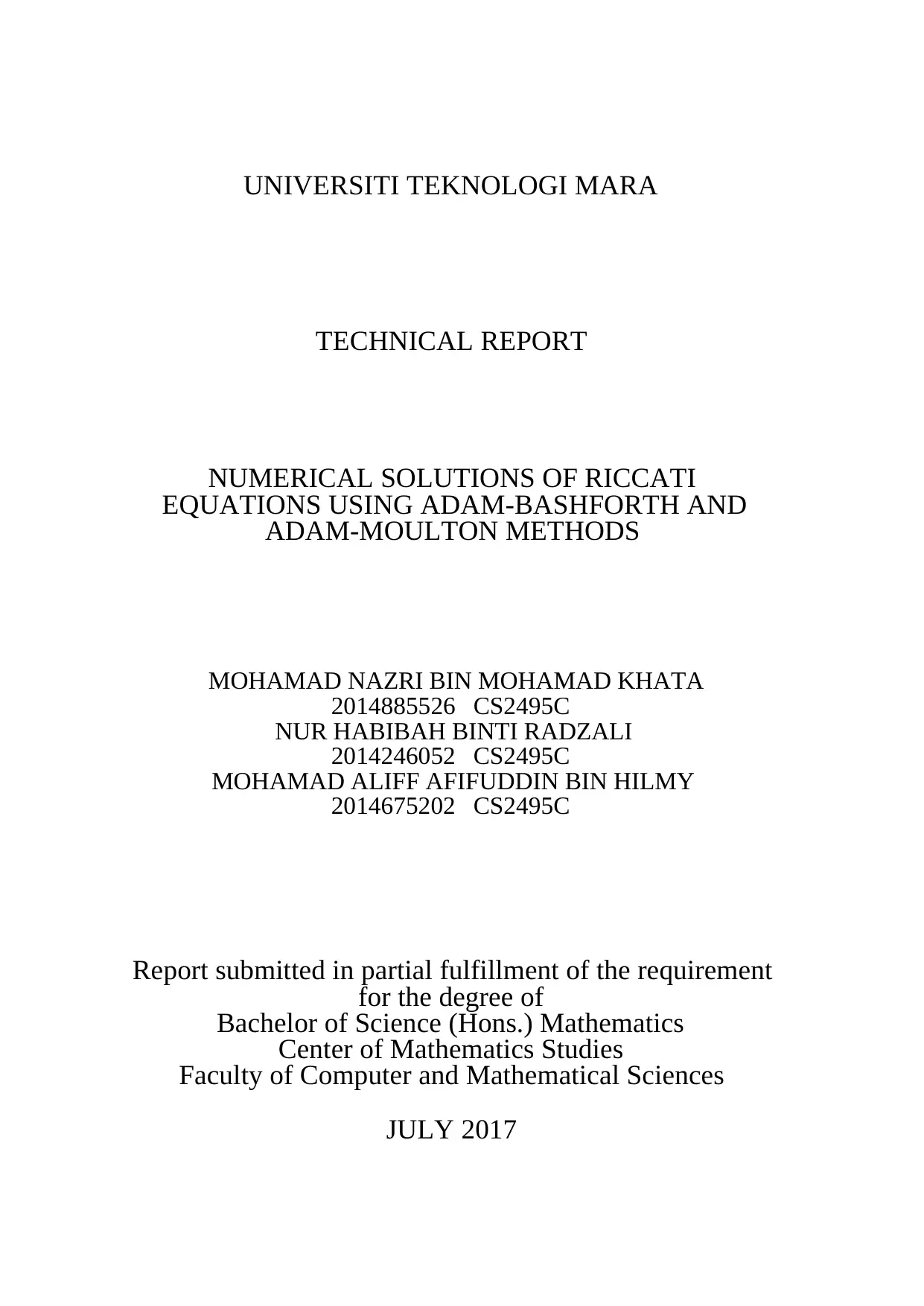
UNIVERSITI TEKNOLOGI MARA
TECHNICAL REPORT
NUMERICAL SOLUTIONS OF RICCATI
EQUATIONS USING ADAM-BASHFORTH AND
ADAM-MOULTON METHODS
MOHAMAD NAZRI BIN MOHAMAD KHATA
2014885526 CS2495C
NUR HABIBAH BINTI RADZALI
2014246052 CS2495C
MOHAMAD ALIFF AFIFUDDIN BIN HILMY
2014675202 CS2495C
Report submitted in partial fulfillment of the requirement
for the degree of
Bachelor of Science (Hons.) Mathematics
Center of Mathematics Studies
Faculty of Computer and Mathematical Sciences
JULY 2017
TECHNICAL REPORT
NUMERICAL SOLUTIONS OF RICCATI
EQUATIONS USING ADAM-BASHFORTH AND
ADAM-MOULTON METHODS
MOHAMAD NAZRI BIN MOHAMAD KHATA
2014885526 CS2495C
NUR HABIBAH BINTI RADZALI
2014246052 CS2495C
MOHAMAD ALIFF AFIFUDDIN BIN HILMY
2014675202 CS2495C
Report submitted in partial fulfillment of the requirement
for the degree of
Bachelor of Science (Hons.) Mathematics
Center of Mathematics Studies
Faculty of Computer and Mathematical Sciences
JULY 2017
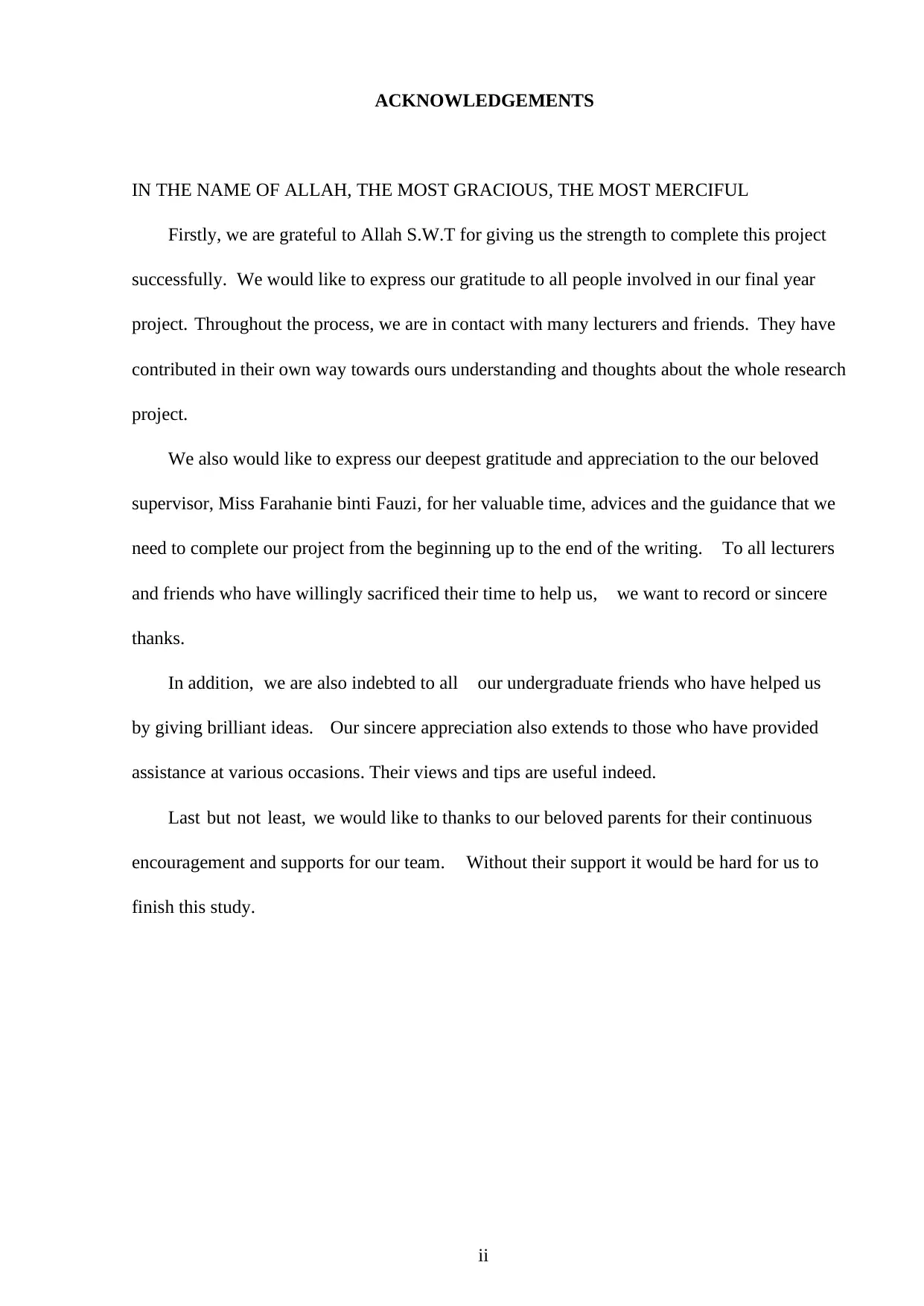
ACKNOWLEDGEMENTS
IN THE NAME OF ALLAH, THE MOST GRACIOUS, THE MOST MERCIFUL
Firstly, we are grateful to Allah S.W.T for giving us the strength to complete this project
successfully. We would like to express our gratitude to all people involved in our final year
project. Throughout the process, we are in contact with many lecturers and friends. They have
contributed in their own way towards ours understanding and thoughts about the whole research
project.
We also would like to express our deepest gratitude and appreciation to the our beloved
supervisor, Miss Farahanie binti Fauzi, for her valuable time, advices and the guidance that we
need to complete our project from the beginning up to the end of the writing. To all lecturers
and friends who have willingly sacrificed their time to help us, we want to record or sincere
thanks.
In addition, we are also indebted to all our undergraduate friends who have helped us
by giving brilliant ideas. Our sincere appreciation also extends to those who have provided
assistance at various occasions. Their views and tips are useful indeed.
Last but not least, we would like to thanks to our beloved parents for their continuous
encouragement and supports for our team. Without their support it would be hard for us to
finish this study.
ii
IN THE NAME OF ALLAH, THE MOST GRACIOUS, THE MOST MERCIFUL
Firstly, we are grateful to Allah S.W.T for giving us the strength to complete this project
successfully. We would like to express our gratitude to all people involved in our final year
project. Throughout the process, we are in contact with many lecturers and friends. They have
contributed in their own way towards ours understanding and thoughts about the whole research
project.
We also would like to express our deepest gratitude and appreciation to the our beloved
supervisor, Miss Farahanie binti Fauzi, for her valuable time, advices and the guidance that we
need to complete our project from the beginning up to the end of the writing. To all lecturers
and friends who have willingly sacrificed their time to help us, we want to record or sincere
thanks.
In addition, we are also indebted to all our undergraduate friends who have helped us
by giving brilliant ideas. Our sincere appreciation also extends to those who have provided
assistance at various occasions. Their views and tips are useful indeed.
Last but not least, we would like to thanks to our beloved parents for their continuous
encouragement and supports for our team. Without their support it would be hard for us to
finish this study.
ii
⊘ This is a preview!⊘
Do you want full access?
Subscribe today to unlock all pages.

Trusted by 1+ million students worldwide
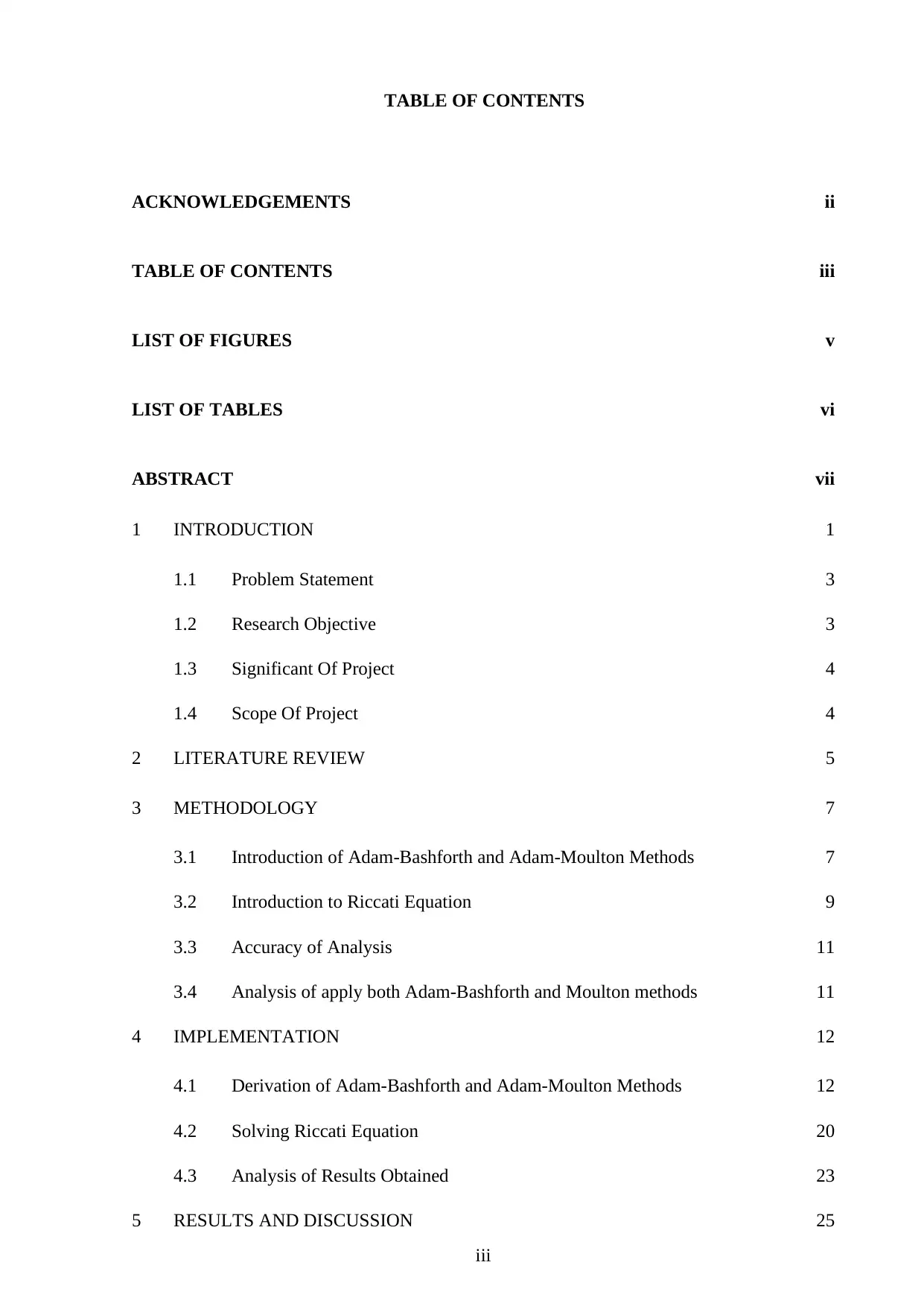
TABLE OF CONTENTS
ACKNOWLEDGEMENTS ii
TABLE OF CONTENTS iii
LIST OF FIGURES v
LIST OF TABLES vi
ABSTRACT vii
1 INTRODUCTION 1
1.1 Problem Statement 3
1.2 Research Objective 3
1.3 Significant Of Project 4
1.4 Scope Of Project 4
2 LITERATURE REVIEW 5
3 METHODOLOGY 7
3.1 Introduction of Adam-Bashforth and Adam-Moulton Methods 7
3.2 Introduction to Riccati Equation 9
3.3 Accuracy of Analysis 11
3.4 Analysis of apply both Adam-Bashforth and Moulton methods 11
4 IMPLEMENTATION 12
4.1 Derivation of Adam-Bashforth and Adam-Moulton Methods 12
4.2 Solving Riccati Equation 20
4.3 Analysis of Results Obtained 23
5 RESULTS AND DISCUSSION 25
iii
ACKNOWLEDGEMENTS ii
TABLE OF CONTENTS iii
LIST OF FIGURES v
LIST OF TABLES vi
ABSTRACT vii
1 INTRODUCTION 1
1.1 Problem Statement 3
1.2 Research Objective 3
1.3 Significant Of Project 4
1.4 Scope Of Project 4
2 LITERATURE REVIEW 5
3 METHODOLOGY 7
3.1 Introduction of Adam-Bashforth and Adam-Moulton Methods 7
3.2 Introduction to Riccati Equation 9
3.3 Accuracy of Analysis 11
3.4 Analysis of apply both Adam-Bashforth and Moulton methods 11
4 IMPLEMENTATION 12
4.1 Derivation of Adam-Bashforth and Adam-Moulton Methods 12
4.2 Solving Riccati Equation 20
4.3 Analysis of Results Obtained 23
5 RESULTS AND DISCUSSION 25
iii
Paraphrase This Document
Need a fresh take? Get an instant paraphrase of this document with our AI Paraphraser
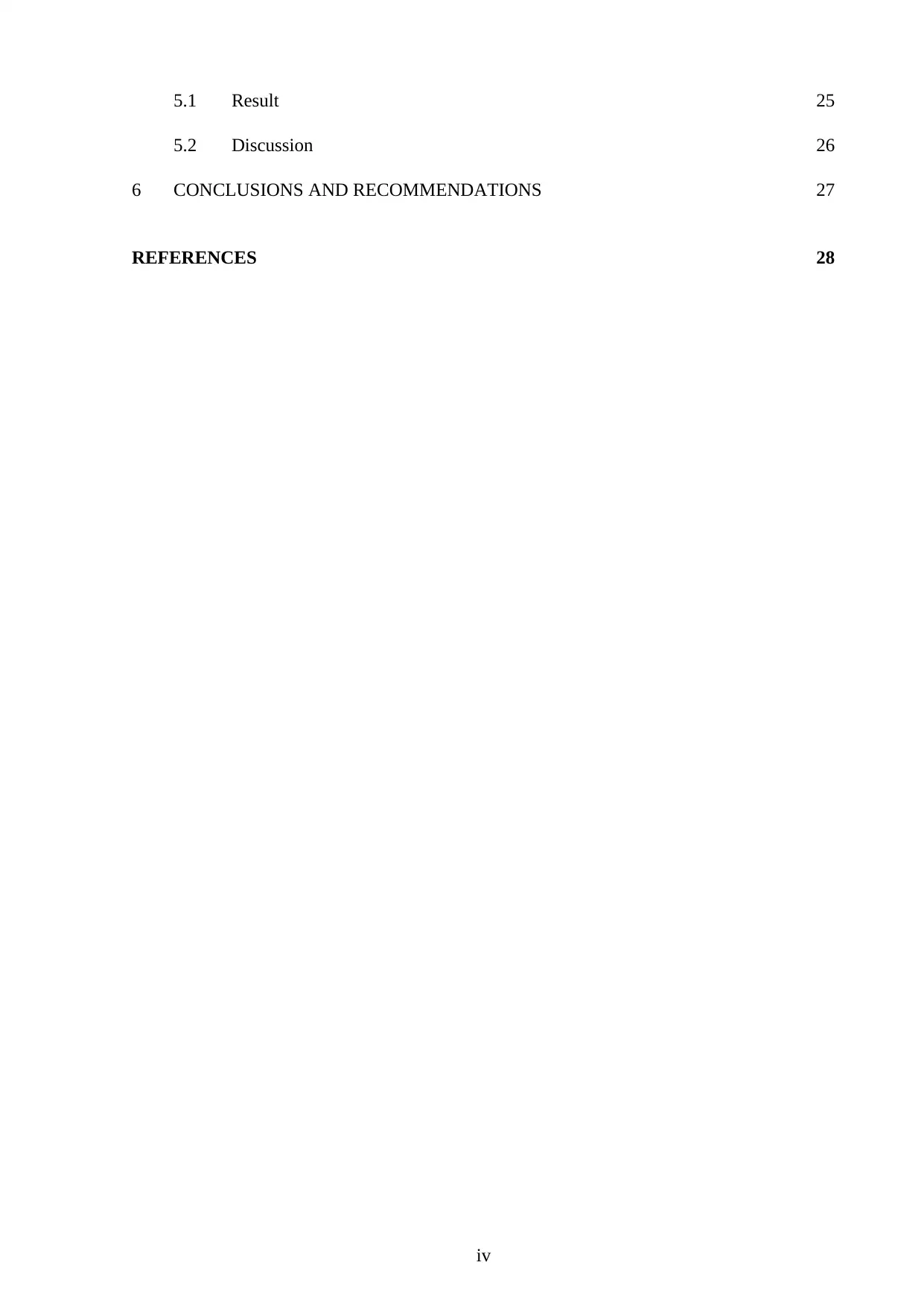
5.1 Result 25
5.2 Discussion 26
6 CONCLUSIONS AND RECOMMENDATIONS 27
REFERENCES 28
iv
5.2 Discussion 26
6 CONCLUSIONS AND RECOMMENDATIONS 27
REFERENCES 28
iv

LIST OF FIGURES
Figure 4.1 Coding of Adam Bashforth 21
Figure 4.2 Coding of Adam Moulton 22
v
Figure 4.1 Coding of Adam Bashforth 21
Figure 4.2 Coding of Adam Moulton 22
v
⊘ This is a preview!⊘
Do you want full access?
Subscribe today to unlock all pages.

Trusted by 1+ million students worldwide
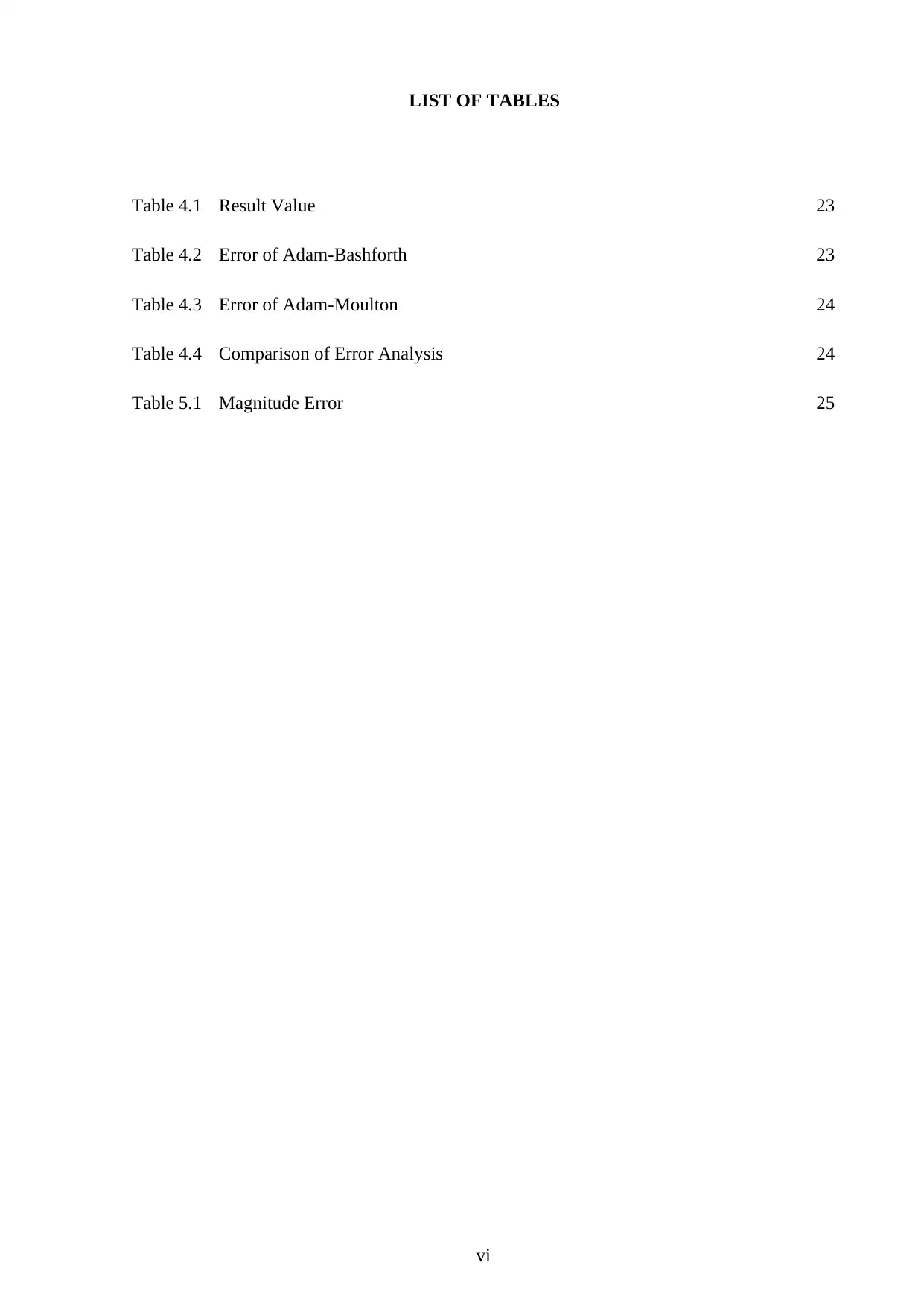
LIST OF TABLES
Table 4.1 Result Value 23
Table 4.2 Error of Adam-Bashforth 23
Table 4.3 Error of Adam-Moulton 24
Table 4.4 Comparison of Error Analysis 24
Table 5.1 Magnitude Error 25
vi
Table 4.1 Result Value 23
Table 4.2 Error of Adam-Bashforth 23
Table 4.3 Error of Adam-Moulton 24
Table 4.4 Comparison of Error Analysis 24
Table 5.1 Magnitude Error 25
vi
Paraphrase This Document
Need a fresh take? Get an instant paraphrase of this document with our AI Paraphraser
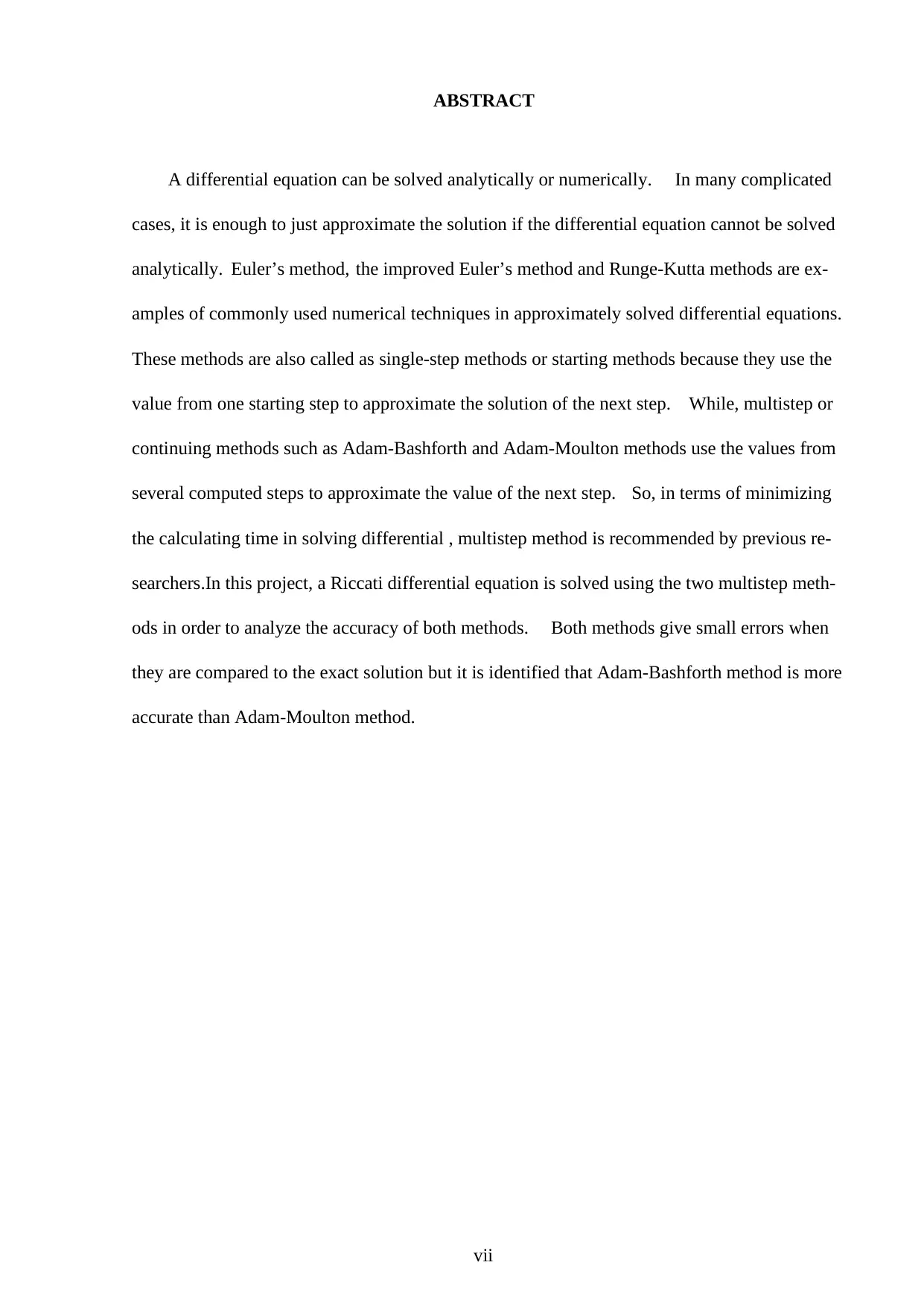
ABSTRACT
A differential equation can be solved analytically or numerically. In many complicated
cases, it is enough to just approximate the solution if the differential equation cannot be solved
analytically. Euler’s method, the improved Euler’s method and Runge-Kutta methods are ex-
amples of commonly used numerical techniques in approximately solved differential equations.
These methods are also called as single-step methods or starting methods because they use the
value from one starting step to approximate the solution of the next step. While, multistep or
continuing methods such as Adam-Bashforth and Adam-Moulton methods use the values from
several computed steps to approximate the value of the next step. So, in terms of minimizing
the calculating time in solving differential , multistep method is recommended by previous re-
searchers.In this project, a Riccati differential equation is solved using the two multistep meth-
ods in order to analyze the accuracy of both methods. Both methods give small errors when
they are compared to the exact solution but it is identified that Adam-Bashforth method is more
accurate than Adam-Moulton method.
vii
A differential equation can be solved analytically or numerically. In many complicated
cases, it is enough to just approximate the solution if the differential equation cannot be solved
analytically. Euler’s method, the improved Euler’s method and Runge-Kutta methods are ex-
amples of commonly used numerical techniques in approximately solved differential equations.
These methods are also called as single-step methods or starting methods because they use the
value from one starting step to approximate the solution of the next step. While, multistep or
continuing methods such as Adam-Bashforth and Adam-Moulton methods use the values from
several computed steps to approximate the value of the next step. So, in terms of minimizing
the calculating time in solving differential , multistep method is recommended by previous re-
searchers.In this project, a Riccati differential equation is solved using the two multistep meth-
ods in order to analyze the accuracy of both methods. Both methods give small errors when
they are compared to the exact solution but it is identified that Adam-Bashforth method is more
accurate than Adam-Moulton method.
vii
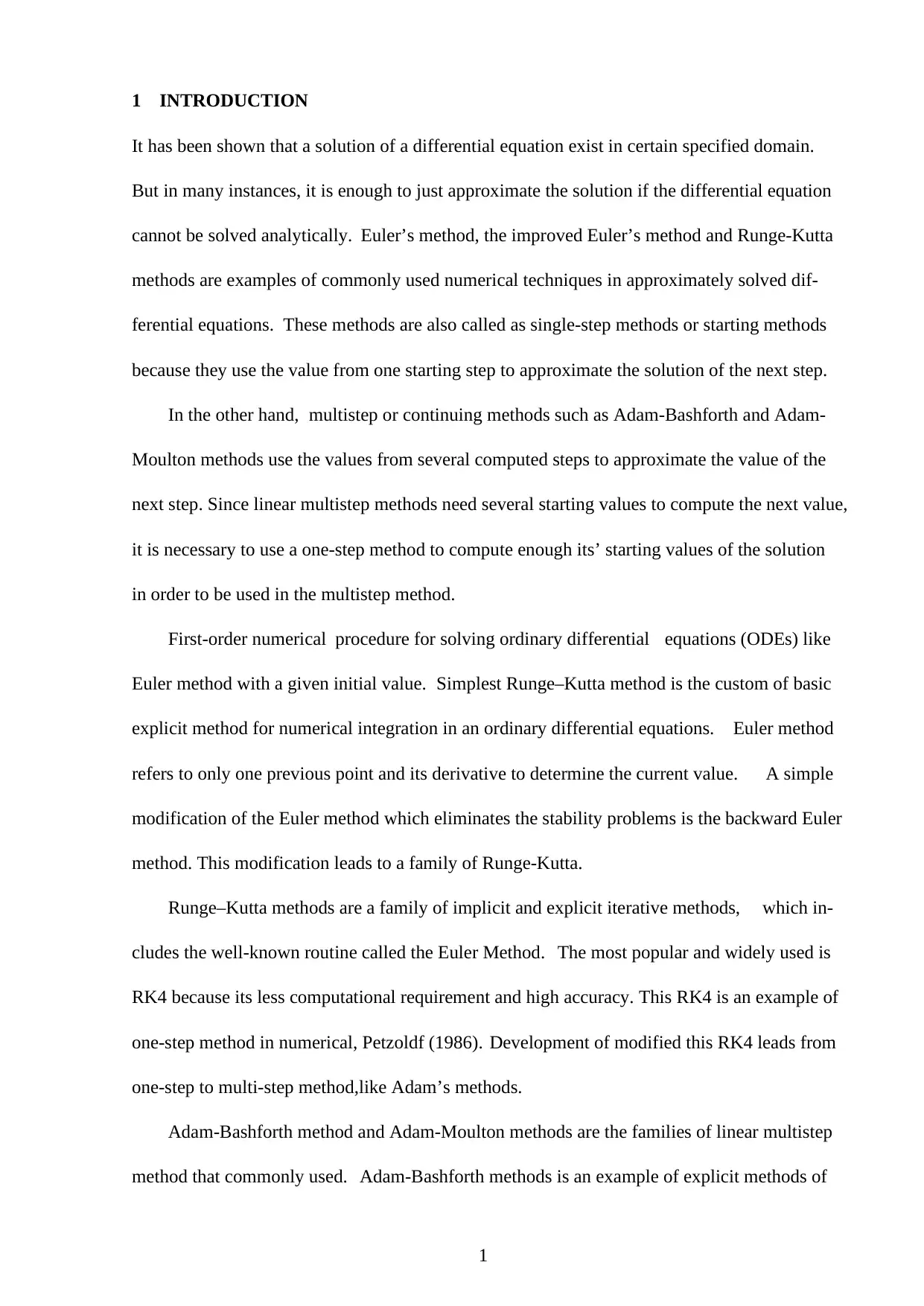
1 INTRODUCTION
It has been shown that a solution of a differential equation exist in certain specified domain.
But in many instances, it is enough to just approximate the solution if the differential equation
cannot be solved analytically. Euler’s method, the improved Euler’s method and Runge-Kutta
methods are examples of commonly used numerical techniques in approximately solved dif-
ferential equations. These methods are also called as single-step methods or starting methods
because they use the value from one starting step to approximate the solution of the next step.
In the other hand, multistep or continuing methods such as Adam-Bashforth and Adam-
Moulton methods use the values from several computed steps to approximate the value of the
next step. Since linear multistep methods need several starting values to compute the next value,
it is necessary to use a one-step method to compute enough its’ starting values of the solution
in order to be used in the multistep method.
First-order numerical procedure for solving ordinary differential equations (ODEs) like
Euler method with a given initial value. Simplest Runge–Kutta method is the custom of basic
explicit method for numerical integration in an ordinary differential equations. Euler method
refers to only one previous point and its derivative to determine the current value. A simple
modification of the Euler method which eliminates the stability problems is the backward Euler
method. This modification leads to a family of Runge-Kutta.
Runge–Kutta methods are a family of implicit and explicit iterative methods, which in-
cludes the well-known routine called the Euler Method. The most popular and widely used is
RK4 because its less computational requirement and high accuracy. This RK4 is an example of
one-step method in numerical, Petzoldf (1986). Development of modified this RK4 leads from
one-step to multi-step method,like Adam’s methods.
Adam-Bashforth method and Adam-Moulton methods are the families of linear multistep
method that commonly used. Adam-Bashforth methods is an example of explicit methods of
1
It has been shown that a solution of a differential equation exist in certain specified domain.
But in many instances, it is enough to just approximate the solution if the differential equation
cannot be solved analytically. Euler’s method, the improved Euler’s method and Runge-Kutta
methods are examples of commonly used numerical techniques in approximately solved dif-
ferential equations. These methods are also called as single-step methods or starting methods
because they use the value from one starting step to approximate the solution of the next step.
In the other hand, multistep or continuing methods such as Adam-Bashforth and Adam-
Moulton methods use the values from several computed steps to approximate the value of the
next step. Since linear multistep methods need several starting values to compute the next value,
it is necessary to use a one-step method to compute enough its’ starting values of the solution
in order to be used in the multistep method.
First-order numerical procedure for solving ordinary differential equations (ODEs) like
Euler method with a given initial value. Simplest Runge–Kutta method is the custom of basic
explicit method for numerical integration in an ordinary differential equations. Euler method
refers to only one previous point and its derivative to determine the current value. A simple
modification of the Euler method which eliminates the stability problems is the backward Euler
method. This modification leads to a family of Runge-Kutta.
Runge–Kutta methods are a family of implicit and explicit iterative methods, which in-
cludes the well-known routine called the Euler Method. The most popular and widely used is
RK4 because its less computational requirement and high accuracy. This RK4 is an example of
one-step method in numerical, Petzoldf (1986). Development of modified this RK4 leads from
one-step to multi-step method,like Adam’s methods.
Adam-Bashforth method and Adam-Moulton methods are the families of linear multistep
method that commonly used. Adam-Bashforth methods is an example of explicit methods of
1
⊘ This is a preview!⊘
Do you want full access?
Subscribe today to unlock all pages.

Trusted by 1+ million students worldwide
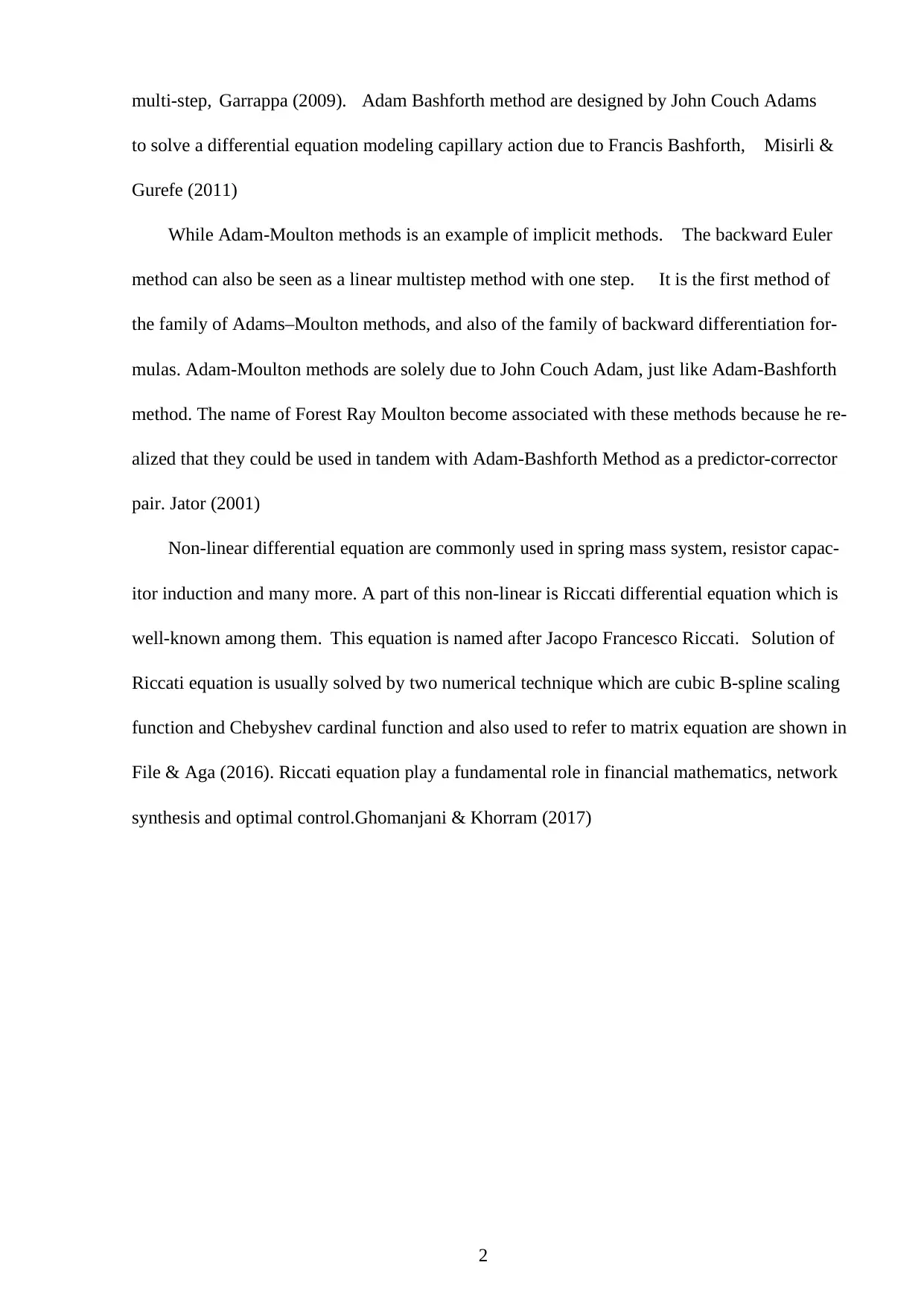
multi-step, Garrappa (2009). Adam Bashforth method are designed by John Couch Adams
to solve a differential equation modeling capillary action due to Francis Bashforth, Misirli &
Gurefe (2011)
While Adam-Moulton methods is an example of implicit methods. The backward Euler
method can also be seen as a linear multistep method with one step. It is the first method of
the family of Adams–Moulton methods, and also of the family of backward differentiation for-
mulas. Adam-Moulton methods are solely due to John Couch Adam, just like Adam-Bashforth
method. The name of Forest Ray Moulton become associated with these methods because he re-
alized that they could be used in tandem with Adam-Bashforth Method as a predictor-corrector
pair. Jator (2001)
Non-linear differential equation are commonly used in spring mass system, resistor capac-
itor induction and many more. A part of this non-linear is Riccati differential equation which is
well-known among them. This equation is named after Jacopo Francesco Riccati. Solution of
Riccati equation is usually solved by two numerical technique which are cubic B-spline scaling
function and Chebyshev cardinal function and also used to refer to matrix equation are shown in
File & Aga (2016). Riccati equation play a fundamental role in financial mathematics, network
synthesis and optimal control.Ghomanjani & Khorram (2017)
2
to solve a differential equation modeling capillary action due to Francis Bashforth, Misirli &
Gurefe (2011)
While Adam-Moulton methods is an example of implicit methods. The backward Euler
method can also be seen as a linear multistep method with one step. It is the first method of
the family of Adams–Moulton methods, and also of the family of backward differentiation for-
mulas. Adam-Moulton methods are solely due to John Couch Adam, just like Adam-Bashforth
method. The name of Forest Ray Moulton become associated with these methods because he re-
alized that they could be used in tandem with Adam-Bashforth Method as a predictor-corrector
pair. Jator (2001)
Non-linear differential equation are commonly used in spring mass system, resistor capac-
itor induction and many more. A part of this non-linear is Riccati differential equation which is
well-known among them. This equation is named after Jacopo Francesco Riccati. Solution of
Riccati equation is usually solved by two numerical technique which are cubic B-spline scaling
function and Chebyshev cardinal function and also used to refer to matrix equation are shown in
File & Aga (2016). Riccati equation play a fundamental role in financial mathematics, network
synthesis and optimal control.Ghomanjani & Khorram (2017)
2
Paraphrase This Document
Need a fresh take? Get an instant paraphrase of this document with our AI Paraphraser
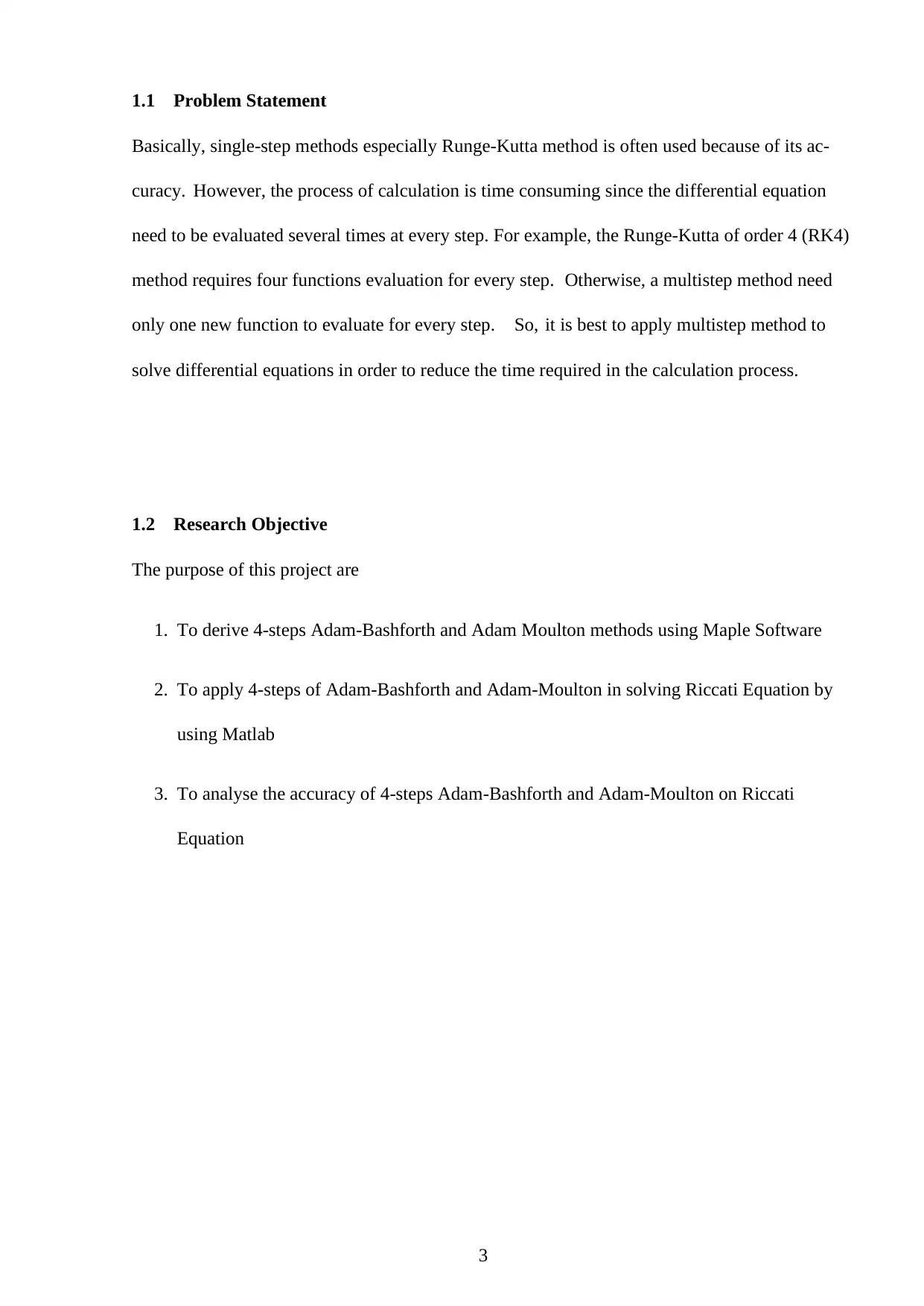
1.1 Problem Statement
Basically, single-step methods especially Runge-Kutta method is often used because of its ac-
curacy. However, the process of calculation is time consuming since the differential equation
need to be evaluated several times at every step. For example, the Runge-Kutta of order 4 (RK4)
method requires four functions evaluation for every step. Otherwise, a multistep method need
only one new function to evaluate for every step. So, it is best to apply multistep method to
solve differential equations in order to reduce the time required in the calculation process.
1.2 Research Objective
The purpose of this project are
1. To derive 4-steps Adam-Bashforth and Adam Moulton methods using Maple Software
2. To apply 4-steps of Adam-Bashforth and Adam-Moulton in solving Riccati Equation by
using Matlab
3. To analyse the accuracy of 4-steps Adam-Bashforth and Adam-Moulton on Riccati
Equation
3
Basically, single-step methods especially Runge-Kutta method is often used because of its ac-
curacy. However, the process of calculation is time consuming since the differential equation
need to be evaluated several times at every step. For example, the Runge-Kutta of order 4 (RK4)
method requires four functions evaluation for every step. Otherwise, a multistep method need
only one new function to evaluate for every step. So, it is best to apply multistep method to
solve differential equations in order to reduce the time required in the calculation process.
1.2 Research Objective
The purpose of this project are
1. To derive 4-steps Adam-Bashforth and Adam Moulton methods using Maple Software
2. To apply 4-steps of Adam-Bashforth and Adam-Moulton in solving Riccati Equation by
using Matlab
3. To analyse the accuracy of 4-steps Adam-Bashforth and Adam-Moulton on Riccati
Equation
3
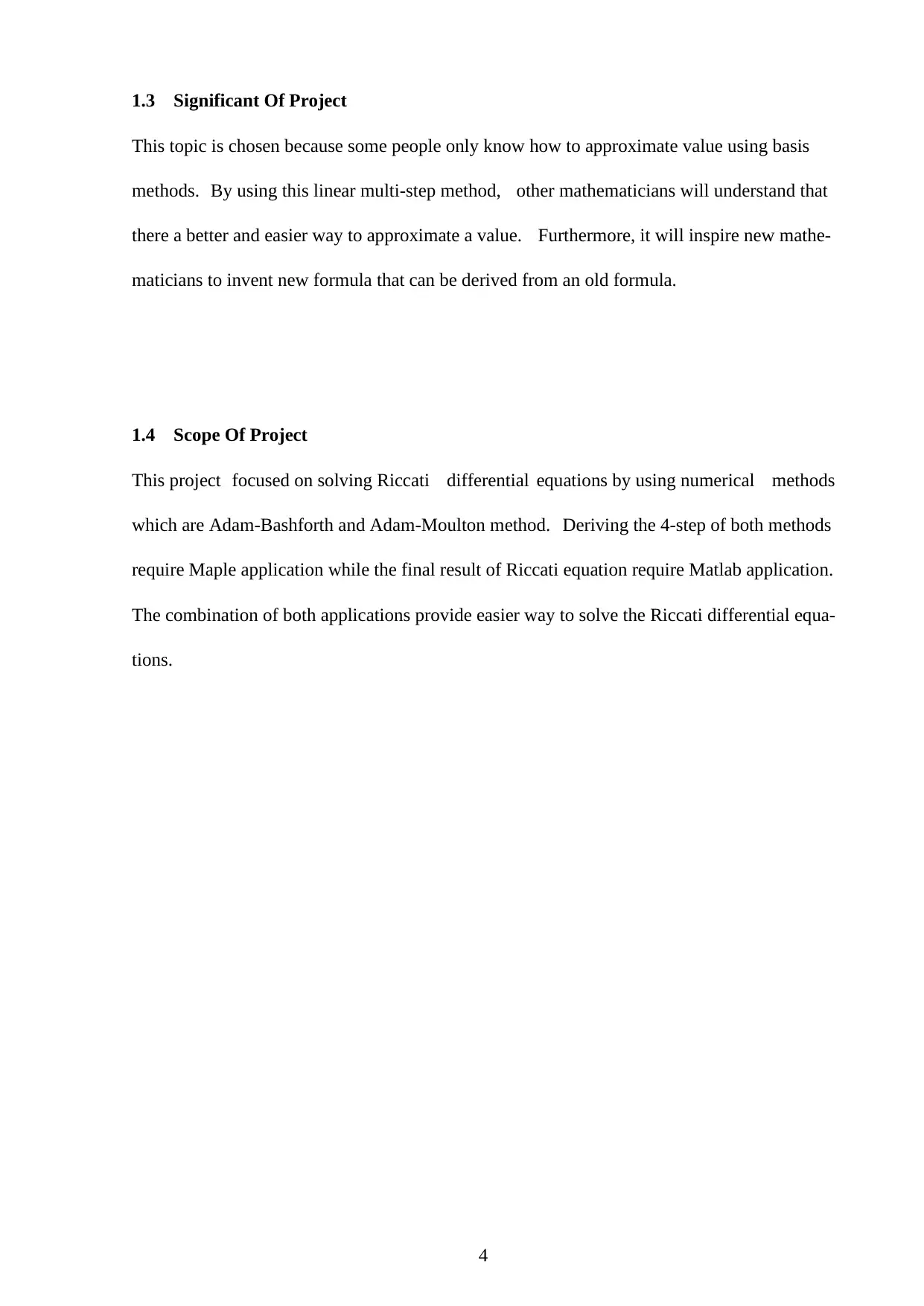
1.3 Significant Of Project
This topic is chosen because some people only know how to approximate value using basis
methods. By using this linear multi-step method, other mathematicians will understand that
there a better and easier way to approximate a value. Furthermore, it will inspire new mathe-
maticians to invent new formula that can be derived from an old formula.
1.4 Scope Of Project
This project focused on solving Riccati differential equations by using numerical methods
which are Adam-Bashforth and Adam-Moulton method. Deriving the 4-step of both methods
require Maple application while the final result of Riccati equation require Matlab application.
The combination of both applications provide easier way to solve the Riccati differential equa-
tions.
4
This topic is chosen because some people only know how to approximate value using basis
methods. By using this linear multi-step method, other mathematicians will understand that
there a better and easier way to approximate a value. Furthermore, it will inspire new mathe-
maticians to invent new formula that can be derived from an old formula.
1.4 Scope Of Project
This project focused on solving Riccati differential equations by using numerical methods
which are Adam-Bashforth and Adam-Moulton method. Deriving the 4-step of both methods
require Maple application while the final result of Riccati equation require Matlab application.
The combination of both applications provide easier way to solve the Riccati differential equa-
tions.
4
⊘ This is a preview!⊘
Do you want full access?
Subscribe today to unlock all pages.

Trusted by 1+ million students worldwide
1 out of 57
Your All-in-One AI-Powered Toolkit for Academic Success.
+13062052269
info@desklib.com
Available 24*7 on WhatsApp / Email
![[object Object]](/_next/static/media/star-bottom.7253800d.svg)
Unlock your academic potential
Copyright © 2020–2025 A2Z Services. All Rights Reserved. Developed and managed by ZUCOL.

